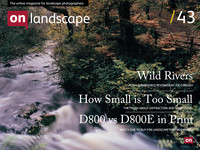Evolving photographic study of the River Dove

Michéla Griffith
In 2012 I paused by my local river and everything changed. I’ve moved away from what many expect photographs to be: my images deconstruct the literal and reimagine the subjective, reflecting the curiosity that water has inspired in my practice. Water has been my conduit: it has sharpened my vision, given me permission to experiment and continues to introduce me to new ways of seeing.
An evolving study of the River Dove and side-stream on the Staffordshire / Derbyshire border
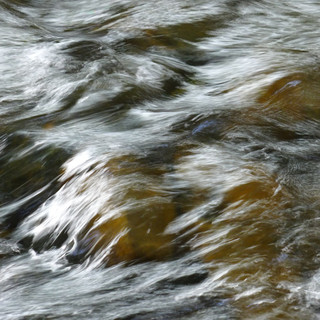 Sheets of rain and roads turn to rivers... Despite some recent respite, for much of the time it’s not been the kind of summer that most of us were hoping for. From a photographer’s viewpoint, at times it’s been hard even to plan local trips when you can’t see the fields, let alone the hills, for low cloud and rain. With such unpredictability, it has often been a case of leaving full kit at home, and going for a walk with a small camera tucked into a pocket ‘just in case’.
Sheets of rain and roads turn to rivers... Despite some recent respite, for much of the time it’s not been the kind of summer that most of us were hoping for. From a photographer’s viewpoint, at times it’s been hard even to plan local trips when you can’t see the fields, let alone the hills, for low cloud and rain. With such unpredictability, it has often been a case of leaving full kit at home, and going for a walk with a small camera tucked into a pocket ‘just in case’.
As weather or light conspire against broader views, it has been good practice in turning eyes and tuning minds to pick out images that are less dependent on ‘good’ light. Of course we all know that there is no such thing as ‘bad’ light - it just may not always suit what you had in mind. However the colours of summer so far seem to have all too often been grey, brown and green.
When I started writing this, I had a clear idea of where it was going. The words came easily, the images less so. What started as a discussion about how the weather had constrained and shaped my photography took an unexpected direction as initial ‘groundwork’ found a new outlet. Subsequently the image making has raced ahead, and it is now time to try to reconcile the two.
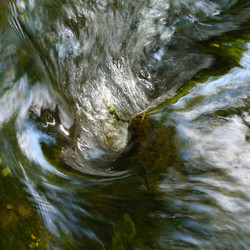 Despite frequently being frustrated by the weather, I’d still managed to create a few images that I was reasonably happy with by looking ‘below the horizon’ and in more detail. In mid-July I set off again, with no clear preconception in mind, just a desire to try to be creative and to get another photographic ‘fix’.
Despite frequently being frustrated by the weather, I’d still managed to create a few images that I was reasonably happy with by looking ‘below the horizon’ and in more detail. In mid-July I set off again, with no clear preconception in mind, just a desire to try to be creative and to get another photographic ‘fix’.
Rob Hudson’s description of himself as a ‘hefted’ photographer struck a chord with me. There are plenty who will literally chase the light and who are drawn to the honeypot views, but for me familiarity with a smaller area is part of the ‘slow photography’ ethos. Something within me is also reluctant to plan for every eventuality, preferring to remain open to the mood and the possibilities that develop. It is after all an art, a creation, rather than a construction. I photograph from the heart as much as the head and an affinity with place is an important part of this. Despite this close connection with the area, I’d just got to the point where I was beginning to wonder if I might run out of ideas and inspiration - dawn has been over-ambitiously early and frequently uninspiring; there has been too little interest in the sky and the usual deterioration in quality of light that accompanies summer days (oh, for winter!) and just too many rank thistles and nettles on the hilltops - when a small section of the River Dove came to my rescue.
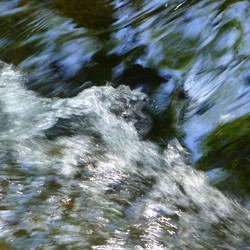 I’ve often stopped at the timber footbridge where the Dove runs in the shadow of Chrome Hill to enjoy the sight and sound of the river as varying water levels find a way between and sometimes over the stones at the side of the ford. On this occasion I made a couple of images and then paused as a group of Duke of Edinburgh students appeared on the far side. I didn’t feel like either giving them a master class in the strange habits of the landscape photographer, or want to rush away, so I loitered while they passed on and out of sight. As is often the case, stopping is good, and other patterns and textures caught my eye.
I’ve often stopped at the timber footbridge where the Dove runs in the shadow of Chrome Hill to enjoy the sight and sound of the river as varying water levels find a way between and sometimes over the stones at the side of the ford. On this occasion I made a couple of images and then paused as a group of Duke of Edinburgh students appeared on the far side. I didn’t feel like either giving them a master class in the strange habits of the landscape photographer, or want to rush away, so I loitered while they passed on and out of sight. As is often the case, stopping is good, and other patterns and textures caught my eye.
While footpaths and trails around Longnor and Hollinsclough tempt with glimpses of the Rivers Dove and Manifold where they cross, the river is frequently at arm’s length and often at a lower level. Here, however, the river is briefly revealed with the ford, several bends, overhanging alder trees, and a small tributary stream. Given yet another uninspiring weather outlook, I had set off with LX5 only. I read a while back that in developing a recognisable style, most photographers stick to one format, so it seems in this at least I may be doomed to failure. However, when I shot only 35mm I saw only 3:2, or 2:3. Using different systems and cameras has opened my eyes and I now see many more possibilities. I do have a soft spot for 1:1, so the LX-5 is perfect for this. Sometimes a square format helps to avoid otherwise intrusive elements, but mostly it just seems to lend itself to composition.
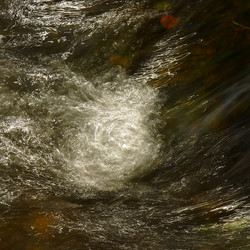 I spent an enjoyable and quiet (for a Saturday morning) hour collecting a selection of ‘moods’ of the river: kaleidoscope colours – blue, black, white, brown, green, orange – patterns and textures, and with a little experimentation with shutter speeds I felt a nice collection of details resulted. If nothing else they were a good reminder of the diversity that can be found in a small area, and that there is a lot more to water than to render it milky smooth.
I spent an enjoyable and quiet (for a Saturday morning) hour collecting a selection of ‘moods’ of the river: kaleidoscope colours – blue, black, white, brown, green, orange – patterns and textures, and with a little experimentation with shutter speeds I felt a nice collection of details resulted. If nothing else they were a good reminder of the diversity that can be found in a small area, and that there is a lot more to water than to render it milky smooth.
I was sufficiently enthused by this to take my initial ‘blog’ idea in a slightly different direction, and to contact Tim to see if the theme might be of interest. A week later, I was still excited by the possibilities, but having returned again, I then saw my initial images as preparatory only. With the opportunity to return, time and patience, and by looking more closely, we often see other possibilities. From a collection of diverse but fairly basic images of surface patterns, textures and colours evolved a study of minor features in the river and stream. These became increasingly abstract, but were I felt more considered compositions. You can see something of this journey at flickr.
I should acknowledge two contributory factors (as well as saying a silent ‘thank you’ to the DoE group who made me pause that first time). The first was that on my initial foray the outlook improved sufficiently for directional light to create reflections on the surface. The next two visits were made on sunny days that for opposite reasons we might dismiss for photography, but the blue sky contributed colour. Yes, I’m curious to experiment in other conditions, but I have to recognise that on the day this influenced the resultant images.
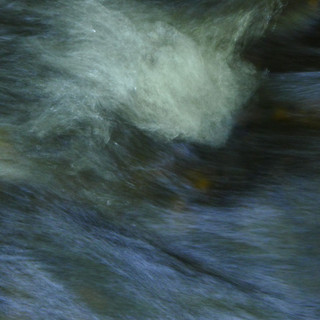 The second is that the LX-5 has progressed from ‘compact sidekick’ to creative tool. Rather than seeking to recreate what I can do with film, it has opened other doors (OK, so maybe I’m a little late in coming to this particular party). The ability to get instant feedback on the effects of shutter speed and exposure compensation, and to vary ISO where needed, has been important. And while I still prefer to hold any camera up to my eye when not on a tripod, I confess that some of the images were taken holding the LX-5 at arm’s length, albeit using both hands and with an elbow resting on a knee for added stability while crouched on the bank above. While I have been, and continue to be reluctant to abandon film, I couldn’t have achieved the same results or progressed the idea so quickly without a digital camera, and I do wonder where this might lead.
The second is that the LX-5 has progressed from ‘compact sidekick’ to creative tool. Rather than seeking to recreate what I can do with film, it has opened other doors (OK, so maybe I’m a little late in coming to this particular party). The ability to get instant feedback on the effects of shutter speed and exposure compensation, and to vary ISO where needed, has been important. And while I still prefer to hold any camera up to my eye when not on a tripod, I confess that some of the images were taken holding the LX-5 at arm’s length, albeit using both hands and with an elbow resting on a knee for added stability while crouched on the bank above. While I have been, and continue to be reluctant to abandon film, I couldn’t have achieved the same results or progressed the idea so quickly without a digital camera, and I do wonder where this might lead.
It’s also been good to concentrate on a particular theme / project to the exclusion of other things. I naturally tend to ‘collect’ a mix of images and styles, and while over time these are hopefully building into something coherent, close application has I think paid dividends.
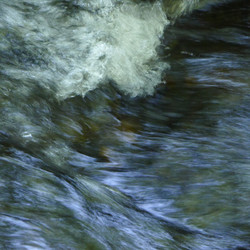 I’ve always enjoyed finding more intimate landscapes, but here there is limited potential for conventionally ‘pretty’ pictures of rivers and streams – nothing grand enough to merit the title waterfall – and in the shadow of Parkhouse & Chrome Hills most would not give this stretch a second glance. I’m fascinated by the abstract colours and patterns that result from very minor incidents in the bed, and the fact that in differing weather and with varying water levels these will come and go and take on, or shed, potential. Of course both the pleasure and the perversion of landscape photography is that things are never the same twice, and this may not be the first time that it proves difficult to recreate the image or the mood. I guess in part that is what keeps us going.
I’ve always enjoyed finding more intimate landscapes, but here there is limited potential for conventionally ‘pretty’ pictures of rivers and streams – nothing grand enough to merit the title waterfall – and in the shadow of Parkhouse & Chrome Hills most would not give this stretch a second glance. I’m fascinated by the abstract colours and patterns that result from very minor incidents in the bed, and the fact that in differing weather and with varying water levels these will come and go and take on, or shed, potential. Of course both the pleasure and the perversion of landscape photography is that things are never the same twice, and this may not be the first time that it proves difficult to recreate the image or the mood. I guess in part that is what keeps us going.
For someone who has had a tendency towards the literal interpretation of landscapes large and small they are a marked change in direction. There is no post-processing or image manipulation here, beyond that of selecting what to include, or exclude, from the frame and of choosing shutter speed. Several images remind me more of paintings than of photographs and these are the images that I am most drawn to. Are these fragmented landscapes photographs or not? I would welcome your thoughts.

